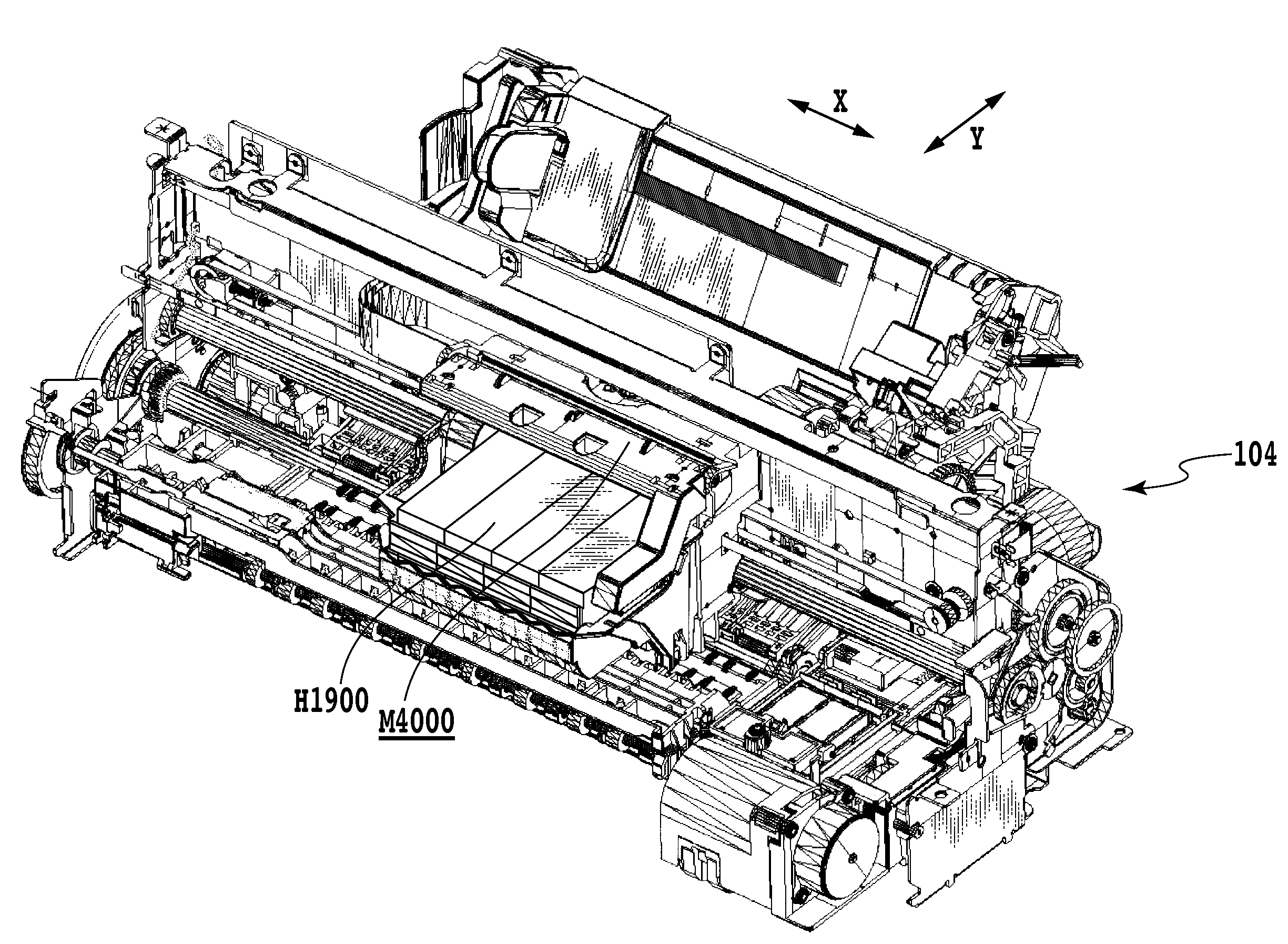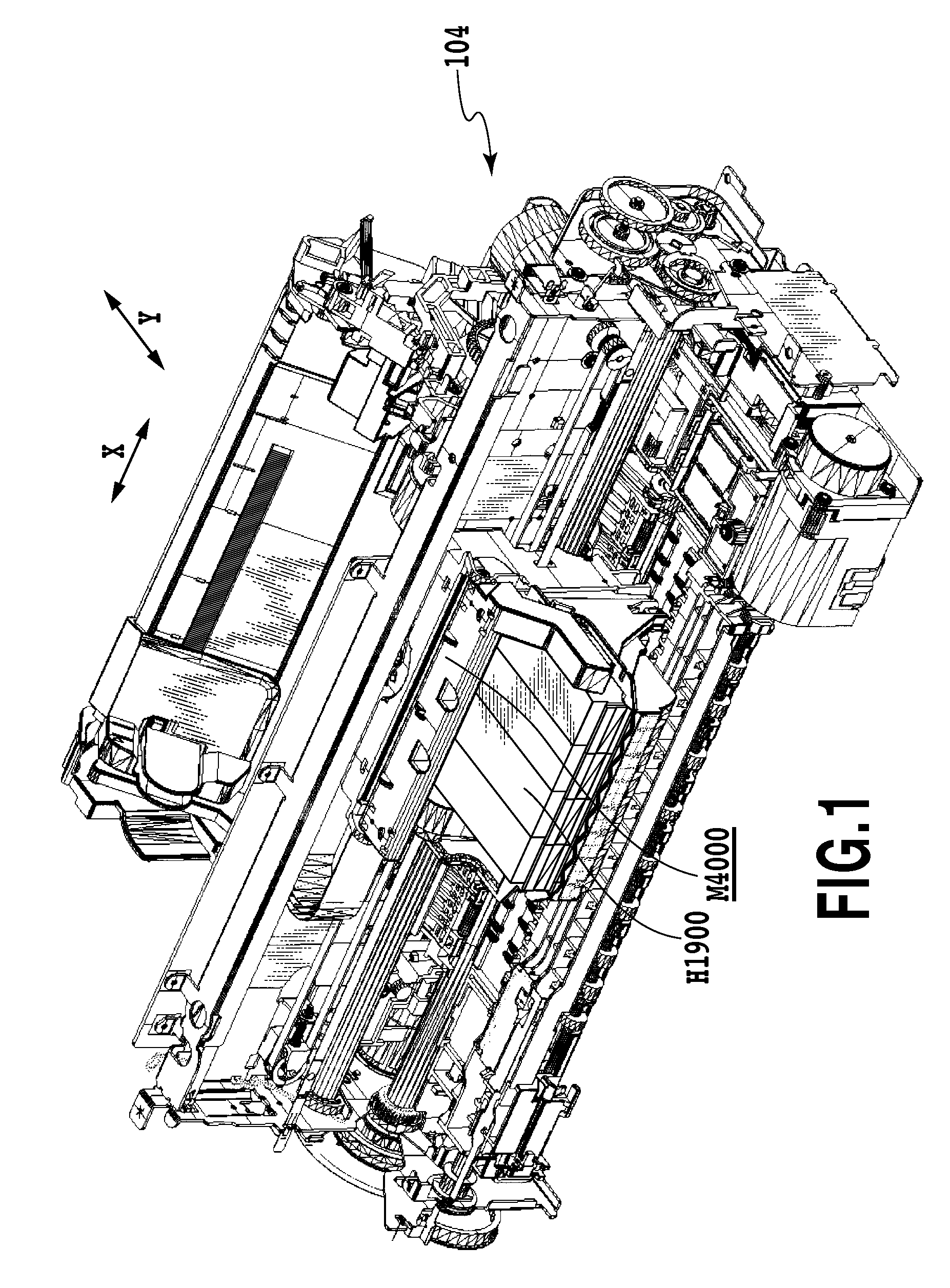Ink jet recording apparatus and ink jet printing method
a recording apparatus and ink jet printing technology, applied in the direction of digitally marking record carriers, visual presentation using printers, instruments, etc., can solve the problems of image quality deterioration, uneven density of printed images, image deterioration
- Summary
- Abstract
- Description
- Claims
- Application Information
AI Technical Summary
Benefits of technology
Problems solved by technology
Method used
Image
Examples
first embodiment
[0047]FIG. 1 is a perspective view showing an ink jet printing apparatus (printer) 104 according to the present embodiment. The carriage M4000 is equipped with print heads and ink tanks H1900 for supplying, respectively, C, M, Y, and K colors of ink to the print heads.
[0048]The printer 104 is a so-called serial type one in which a print head adapted to eject ink scans a printing medium during which the ink is ejected for printing. The print heads are prepared to correspond respectively to cyan (C), magenta (M), yellow (Y), and black (K) colors of ink. Then the print heads can scan a printing medium such as printing paper by being attached to the carriage.
[0049]The carriage M4000 moves in the main scan direction (X direction in the drawing) and each nozzle in the print heads ejects ink at a predetermined timing based on binary separate printing data. After one primary scanning of the print heads, the printing medium is conveyed in the sub-scan direction (Y direction in the drawing) b...
second embodiment
[0085]Although the first embodiment is for the case where a user selects the most suitable test pattern of smaller density difference from plurality test patterns differs of printing ratio based on visible of the user. However, the present invention is not restricted to such a case where a user makes a selection based on visible of the user. For example, a density sensor such as an optical sensor may be used to measure the optical characteristics of test patterns and thereby to select a test pattern of smaller density difference.
[0086]FIG. 13 is a flow chart schematically showing processing for printing ratio selection according to the present embodiment. Predetermined test patterns are first printed (S131), as is the case in the first embodiment. Next, a density sensor installed in the printer 104 is used to measure the optical characteristics (for example, reflective optical density) of the printed test patterns (S132). Then, a test pattern without unevenness is determined based o...
third embodiment
[0091]Although test patterns are printed in the entire width of main scan direction of a printing medium in the first and second embodiments, the present invention is not restricted to such test patterns. In the present embodiment, printing is not performed through the entire width of main scan direction of a printing medium, but is performed with a weight depending on the time difference between scanning thereof.
[0092]The present embodiment can be applied regardless of whether the size of a printing medium is given in advance. The case where the size of a printing medium is not given in advance will hereinafter be described. If the size of a printing medium is given in advance, test patterns may be printed based on a predefined time between scanning without calculating the time between scanning.
[0093]FIG. 15 is a flow chart schematically showing processing for printing ratio selection according to the present embodiment. The time difference between scanning is first calculated base...
PUM
 Login to View More
Login to View More Abstract
Description
Claims
Application Information
 Login to View More
Login to View More - R&D
- Intellectual Property
- Life Sciences
- Materials
- Tech Scout
- Unparalleled Data Quality
- Higher Quality Content
- 60% Fewer Hallucinations
Browse by: Latest US Patents, China's latest patents, Technical Efficacy Thesaurus, Application Domain, Technology Topic, Popular Technical Reports.
© 2025 PatSnap. All rights reserved.Legal|Privacy policy|Modern Slavery Act Transparency Statement|Sitemap|About US| Contact US: help@patsnap.com



